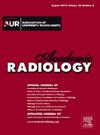Triple Rule Out CT in the Emergency Department: Clinical Risk and Outcomes (Triple Rule Out in the Emergency Department)
IF 3.8
2区 医学
Q1 RADIOLOGY, NUCLEAR MEDICINE & MEDICAL IMAGING
引用次数: 0
Abstract
Rationale and Objectives
Triple rule out CT protocols (TRO-CT) have been advocated as a single test to simultaneously evaluate major causes of acute chest pain, in particular acute myocardial infarction (MI), acute pulmonary embolism (PE), and acute aortic syndrome. However, it is unclear what patient populations would benefit from a such comprehensive exam and current guidelines recommend tailoring CT protocols to the most likely diagnosis.
Methods
We retrospectively reviewed TRO-CT scans performed from the Emergency Department (ED) at our institution from April 2021 to April 2022. Charts were reviewed to calculate clinical risk of MI, PE, and acute aortic syndrome using conventional clinical scoring systems (HEART score, PERC score, ADD-RS). TRO-CT findings and 30-day clinical outcomes were recorded from chart review.
Results
1279 patients ED patients scanned with TRO-CT were included in the analysis. 831 patients (65.0%) were at-risk for two or more clinical risk scores. At TRO-CT, 381 (29.8%) patients had obstructive CAD. 91 (7.1%) had acute PE. 7 (0.5%) had acute aortic syndrome. At 30-day clinical follow up, 28 patients (2.2%) had the diagnosis of acute MI (95% CI: 1.5–3.2%). 90 patients (7.0%) had the diagnosis of acute PE (95% CI: 5.7–8.6%). 7 patients (0.5%) had the diagnosis acute aortic syndrome (95% CI: 0.2–1.2%). A low-risk HEART score was associated with a 0.3% 30-day clinical diagnosis of acute MI (95% CI: 0.0–1.6%). Low-risk-PERC was associated with a 2.9% 30-day clinical diagnosis of acute PE (95% CI: 0.7–8.7%). Low-risk ADD-RS was associated with a 0.3% 30-day clinical diagnosis of acute aortic syndrome (95% CI: 0.0–1.8%).
Conclusions
We found a high clinical overlap in the presentation of acute MI, acute PE, and acute aortic syndrome based on clinical risk scores. Further studies will be needed to compare a TRO-CT algorithm to a standard-of-care algorithm in patients presenting to the ED.
在急诊科三重排除CT:临床风险和结果(急诊科三重排除)。
原理和目的:三重排除CT方案(TRO-CT)一直被提倡作为一种单一的测试,同时评估急性胸痛的主要原因,特别是急性心肌梗死(MI)、急性肺栓塞(PE)和急性主动脉综合征。然而,目前尚不清楚哪些患者群体会从这种全面的检查中受益,目前的指导方针建议根据最可能的诊断调整CT方案。方法:我们回顾性回顾了从2021年4月至2022年4月在我院急诊科(ED)进行的TRO-CT扫描。使用常规临床评分系统(HEART评分、PERC评分、ADD-RS)评估心肌梗死、PE和急性主动脉综合征的临床风险。从图表回顾中记录TRO-CT结果和30天临床结果。结果:1279例经TRO-CT扫描的ED患者纳入分析。831例(65.0%)患者在两个或两个以上的临床风险评分中处于危险状态。在TRO-CT上,381例(29.8%)患者为阻塞性CAD。91例(7.1%)有急性PE。7例(0.5%)有急性主动脉综合征。在30天的临床随访中,28例(2.2%)被诊断为急性心肌梗死(95% CI: 1.5-3.2%)。90例(7.0%)诊断为急性PE (95% CI: 5.7 ~ 8.6%)。7例(0.5%)诊断为急性主动脉综合征(95% CI: 0.2 ~ 1.2%)。低危HEART评分与0.3%的30天急性心肌梗死临床诊断相关(95% CI: 0.0-1.6%)。低风险perc与2.9%的30天急性PE临床诊断相关(95% CI: 0.7-8.7%)。低危ADD-RS与0.3%的30天急性主动脉综合征临床诊断相关(95% CI: 0.0-1.8%)。结论:我们发现基于临床风险评分的急性心肌梗死、急性肺脏和急性主动脉综合征的临床表现有很高的重叠。在急诊科患者中,需要进一步的研究来比较TRO-CT算法与标准护理算法。
本文章由计算机程序翻译,如有差异,请以英文原文为准。
求助全文
约1分钟内获得全文
求助全文
来源期刊

Academic Radiology
医学-核医学
CiteScore
7.60
自引率
10.40%
发文量
432
审稿时长
18 days
期刊介绍:
Academic Radiology publishes original reports of clinical and laboratory investigations in diagnostic imaging, the diagnostic use of radioactive isotopes, computed tomography, positron emission tomography, magnetic resonance imaging, ultrasound, digital subtraction angiography, image-guided interventions and related techniques. It also includes brief technical reports describing original observations, techniques, and instrumental developments; state-of-the-art reports on clinical issues, new technology and other topics of current medical importance; meta-analyses; scientific studies and opinions on radiologic education; and letters to the Editor.
 求助内容:
求助内容: 应助结果提醒方式:
应助结果提醒方式:


